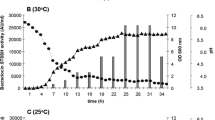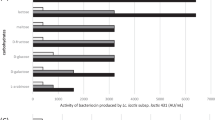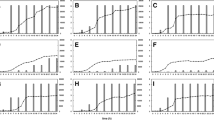Abstract
Bacteriocins are ribosomally synthesized antimicrobial peptides secreted by certain lactic acid bacteria, with potential application in food safety. Bacteriocin-producing Lactobacillus plantarum LD4 was identified using biochemical and molecular techniques including 16S rDNA amplification, followed by sequencing. Bacteriocin production started after 3 h, reaching a maximum during the early stationary phase. Bacteriocin present in cell-free supernatant showed stability in a pH range of 2.0 to 6.0, as well as at different temperatures (60–100 and 121 °C for 15 min under 15 psi pressure). Antimicrobial activity was not affected by catalase, lipase or α-amylase, but was reduced in the presence of trypsin and protease, suggesting the proteinaceous nature of the compound. Activity remained stable after treatment with different organic solvents, surfactants, and detergents. The molecular weight of bacteriocin LD4 was found to be ∼6 kDa using tricine SDS-PAGE. Antimicrobial activity was demonstrated against Gram-positive and Gram-negative bacteria including Micrococcus luteus, Staphylococcus aureus, Escherichia coli, Pseudomonas aeruginosa, Salmonella typhi, Vibrio sp., Enterobacter cloacae, Enterococcus faecium, and a few strains of lactic acid bacteria and haloarchaea. Bacteriocin LD4 caused K+ ion efflux in target cells, suggesting the pore-forming nature of the compound. Given the stability under various conditions and the broad antimicrobial spectrum against pathogens, the bacteriocin LD4 has the potential for application in food safety as well as therapeutics.





Similar content being viewed by others
References
Aunpad R, Na-Bangchang K (2007) Pumilicin 4, a novel bacteriocin with anti-MRSA and anti-VRE activity produced by newly isolated bacteria Bacillus pumilus strain WAPB4. Curr Microbiol 55:308–313
Battcock M, Azam-Ali S (1998) Fermented fruits and vegetables: a global perspective. Food and Agriculture Organization of the United Nations, Rome
Bendjeddou K, Fons M, Strocker P, Sadoun D (2012) Characterization and purification of a bacteriocin from Lactobacillus paracasei subsp. paracasei BMK2005, an intestinal isolate active against multidrug-resistant pathogens. World J Microbiol Biotechnol 28:1543–1552
Birbir M, Eryilmaz S, Ogan A (2004) Prevention of halophilic microbial damage on brine cured hides by extremely halophilic halocin producer strains. J Soc Leather Technol Chem 88:99–104
Chen YS, Wang YC, Chow YS, Yanagida F, Liao CC, Chiu CM (2014) Purification and characterization of plantaricin Y, a novel bacteriocin produced by Lactobacillus plantarum 510. Arch Microbiol 196:193–199
Cleveland J, Montville TJ, Nes IF, Chikindas ML (2001) Bacteriocins: safe, natural antimicrobials for food preservation. Int J Food Microbiol 71:1–20
Gong HS, Meng XC, Wang H (2010) Mode of action of plantaricin MG, a bacteriocin active against Salmonella typhimurium. J Basic Microbiol 50:S37–S45
Gupta A, Tiwari SK (2014) Plantaricin LD1: a bacteriocin produced by food isolate of Lactobacillus plantarum LD1. Appl Biochem Biotechnol 172:3354–3362
Hassanshahian M, Mohamadian J (2011) Isolation and characterization of Halobacterium salinarum from saline lakes in Iran. Jundishapur J Microbiol 4:S59–S65
Henderson JT, Chopko AL, van Wassenaar PD (1992) Purification and primary structure of pediocin PA-1 produced by Pediococcus acidilactici PAC-1.0. Arch Biochem Biophys 295:5–12
Heng NCK, Wescombe PA, Burton JP, Jack RW, Tagg JR (2007) The diversity of bacteriocins in gram-positive bacteria. In: Riley MA, Chavan MA, editors. Bacteriocins: ecology and evolution. Berlin; Heidelberg; New York: Springer. p 45-92.
Holo H, Jeknic Z, Daeschel M, Stevanovic S, Nes IF (2001) Plantaricin W from Lactobacillus plantarum belongs to a new family of two-peptide lantibiotics. Microbiology 147:643–651
Kumar M, Tiwari SK, Srivastava S (2010) Purification and characterization of enterocin LR/6, a bacteriocin from Enterococcus faecium LR/6. Appl Biochem Biotechnol 160:40–49
Lee HS (2013) Diversity of halophilic archaea in fermented foods and human intestine and their applications. J Microbiol Biotechnol 23:1645–1653
Lemos MM, Dias DCA, Ferreira GLS (2008) Inhibition of vancomycin and high-level aminoglycoside-resistant enterococci strains and Listeria monocytogenes by bacteriocin-like substance produced by Enterococcus faecium E86. Curr Microbiol 57:429–436
Messi P, Bondi M, Sabia C, Battini R, Manicardi G (2001) Detection and preliminary characterization of a bacteriocin (plantaricin 35d) produced by a Lactobacillus plantarum strain. Int J Food Microbiol 64:193–198
Morisset D, Berjeaud JM, Marion D, Lacombe C, Frere J (2004) Mutational analysis of mesentericin y105, an anti-Listeria bacteriocin, for determination of impact on bactericidal activity, in vitro secondary structure and membrane interaction. Appl Environ Microbiol 70:4672–4680
Ndlovu B, Schoeman H, Franz CMAP, du Toit M (2015) Screening, identification and characterization of bacteriocins produced by wine-isolated LAB strains. J Appl Microbiol 118:1007–1022
Nishie M, Nagao J, Sonomoto K (2012) Antibacterial peptides “bacteriocins”: an overview of their diverse characteristics and applications. Biocontrol Sci 17:1–16
Ogunbanwo ST, Sanni AI, Onilude AA (2003) Characterization of bacteriocin produced by Lactobacillus plantarum F1 and Lactobacillus brevis OG1. Afr J Biotechnol 2:219–227
Olasupo NA (1996) Bacteriocins of Lactobacillus plantarum strains from fermented foods. Folia Microbiol 41:130–136
Pasic L, Velikonja BH, Ulrih NP (2008) Optimization of the culture conditions for the production of a bacteriocin from halophilic archaean Sech7a. Prep Biochem Biotechnol 38:229–245
Perez RH, Zendo T, Sonomoto K (2014) Novel bacteriocins from lactic acid bacteria (LAB): various structures and applications. Microb Cell Factories 13:S3
Riazi S, Dover SE, Chikindas ML (2012) Mode of action and safety of lactosporin, a novel antimicrobial protein produced by Bacillus coagulans ATCC 7050. J Appl Microbiol 113:714–722
Rushdy AA, Gomaa EZ (2013) Antimicrobial compounds produced by probiotic Lactobacillus brevis isolated from dairy products. Ann Microbiol 63:81–90
Sahingil D, Isleroglu H, Yildirim Z, Alçelik M, Yildrim M (2011) Characterization of lactococcin BZ produced by Lactococcus lactis subsp. lactis BZ isolated from boza. Turk J Biol 35:21–33
Saidi N, Hadadji M, Guessas B (2011) Screening of bacteriocin-producing lactic acid bacteria isolated from West Algerian goat’s milk. Global J Biotechnol Biochem 6:154–161
Schägger H, von Jagow G (1987) Tricine-sodium dodecyl sulphate-polyacrilamide gel electrophoresis for the separation of proteins in the range from 1 to 100 kDa. Anal Biochem 166:368–379
Song DF, Zhu MY, Gu Q (2014) Purification and characterization of plantaricin ZJ5, a new bacteriocin produced by Lactobacillus plantarum ZJ5. PLoS ONE 9:e105549
Stevens KA, Sheldon BW, Klapes NA, Klaenhammer TR (1991) Nisin treatment for inactivation of Salmonella species and other Gram-negative bacteria. Appl Environ Microbiol 57:3613–3615
Tiwari SK, Srivastava S (2008a) Characterization of a bacteriocin from Lactobacillus plantarum Strain LR/14. Food Biotechnol 22:247–261
Tiwari SK, Srivastava S (2008b) Purification and characterization of plantaricin LR14: a novel bacteriocin produced by Lactobacillus plantarum LR/14. Appl Microbiol Biotechnol 79:759–767
Tiwari SK, Noll SK, Cavera VL, Chikindas ML (2015) Improved antimicrobial activity of synthetic-hybrid bacteriocins designed from enterocin E50-52 and pediocin PA-1. Appl Environ Microbiol 81:1661–1667
Todorov SD, Dicks LMT (2005) Lactobacillus plantarum isolated from molasses produces bacteriocins active against Gram‐negative bacteria. Enzym Microb Technol 36:318–326
Todorov SD, Onno B, Sorokine O, Chobert JM, Ivanova I, Dousset X (1999) Detection and characterization of a novel antibacterial substance produced by Lactobacillus plantarum ST 31 isolated from sourdough. Int J Food Microbiol 48:167–177
Tuncer Y, Ozden B (2010) Partial biochemical characterization of nisin-like bacteriocin produced by Lactococcus lactis subsp. lactis YBD11 isolated from Boza, a traditional fermented Turkish beverage. Rom Biotechnol Lett 15:4940–4948
Zaeim D, Soleimanian-Zad S, Sheikh-Zeinoddin M (2014) Identification and partial characterization of a bacteriocin-like inhibitory substance (BLIS) from Lb. Bulgaricus K41 isolated from indigenous yogurts. J Food Sci 79:67–73
Zhang H, Liu L, Hao Y, Zhong S, Liu H, Han T, Xie Y (2013) Isolation and partial characterization of a bacteriocin produced by Lactobacillus plantarum BM-1 isolated from a traditionally fermented Chinese meat product. Microbiol Immunol 57:746–755
Acknowledgments
VK was supported by a UGC-BSR fellowship, University Grant Commission, New Delhi. The authors acknowledge the facilities provided under UGC-SAP and DST-FIST programmes in Department of Genetics, Maharshi Dayanand University, Rohtak.
Author information
Authors and Affiliations
Corresponding author
Rights and permissions
About this article
Cite this article
Kumar, V., Sheoran, P., Gupta, A. et al. Antibacterial property of bacteriocin produced by Lactobacillus plantarum LD4 isolated from a fermented food. Ann Microbiol 66, 1431–1440 (2016). https://doi.org/10.1007/s13213-016-1230-6
Received:
Accepted:
Published:
Issue Date:
DOI: https://doi.org/10.1007/s13213-016-1230-6




